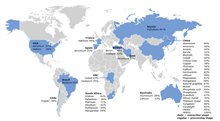International trade flows
Trade flows of critical raw materials depend on global supply and demand. Mineral deposits, formed under specific geological conditions, determine where in the world the trade flow begins. The Netherlands Materials Observatory (NMO) provides insight into the origin of these trade flows through its knowledge of geology, production potential, extraction, processing, and trade of critical raw materials. By doing so, the NMO incorporates essential knowledge on raw materials sources to analyse supply chains that are important to the Dutch economy.
Dependence on critical raw materials
In recent years, the European Union (EU) has recognized that the European economy is highly dependent on the availability and supply of critical raw materials from a small number of specific countries outside the EU. This dependence makes the European economy vulnerable.
As an EU Member State, the Netherlands is subject to these dependencies and vulnerabilities. The Netherlands also aims to maintain its high level of prosperity, keep Dutch industry healthy, and realise the energy and digital transitions.
As a trading country with limited geological potential in its own subsurface, the Netherlands remains dependent on international trade flows of critical raw materials. That is why the NMO plays an important role by consolidating knowledge about the geological context at the origin of international trade flows.
Mapping raw materials
Understanding the global raw materials market is essential for analysing European and Dutch dependence on critical raw materials. The map below, from a recent European Commission study, demonstrates which countries are currently the world's leading producers of critical raw materials. It shows that many critical raw materials originate from China. It highlights the EU’s reliance on a small number of specific countries for the supply of many of these materials. More information on this figure can be found in the European Commission study.
Source: European Commission, Study on the critical raw materials for the EU 2023 – Final report, 2023
What does the NMO do?
To identify trade flows, it is necessary to identify their source. The NMO provides insight into the source of international trade flows through its knowledge of the geology, extraction, processing, and trade of critical raw materials. This information helps to identify dependencies and vulnerabilities that affect the Dutch economy throughout the supply chain. It can also assist in making economically strategic decisions on imports, storage, and transit, and in determining any strategic stocks. In addition, the NMO is committed to knowledge cooperation with (resource-rich) countries outside the EU - as part of Dutch or European CRM partnerships - that can improve Dutch and European access to critical raw materials.

